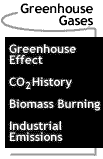

 |
Greenhouse Gases The gases primarily responsible for trapping Earth's outgoing energy are water vapor, CO2, CH4 (methane), N2O (nitrous oxide), O3 (ozone), CFCs (chlorofluorocarbons), and HCFCs (hydro chlorofluorocarbons). This trapping is known as the greenhouse effect. Since the beginning of the industrial era, around 1850, the concentration of CO2, CH4, N2O, O3 , and CFCs and HCFCs has risen steadily. Anthropogenic emissions (those caused by humans) consist primarily of CO2, CH4, CO, and N2O. With the aid of sunlight, CH4, CO, N2O, and other hydrocarbons help form O3 in the lower levels of the atmosphere. The amount of water vapor in the atmosphere is not directly affected by human activity. However, as the temperature increases due to increasing levels of the other gases, it is expected that water vapor levels will also increase. CO2 emissions constitute over 90% of all anthropogenic emissions, so the other gases are generally referred to in terms of their CO2 equivalent effect. While CO2 may be the dominant gas by amount, the other greenhouse gases are more efficient at trapping outgoing IR radiation. The amount of time the gas spends in the atmosphere is also important: the longer the time, the more energy trapped. A factor called the Global Warming Potential (GWP) is calculated for each gas, based on the above two effects: efficiency at trapping IR radiation and time in the atmosphere. CO2 has a GWP = 1. CH4 has a GWP = 25, and CFCs and HCFCs have GWPs ranging from 100 to 12,000. The GWP tells us that one molecule of CH4 has the same effect as twenty-five CO2 molecules. It may be more beneficial, in certain situations, to control emissions of CH4 or CFCs depending on the amount of these emissions relative to CO2.
[ Greenhouse Gases: Greenhouse Effects / [ Home ] [ Teacher Pages ] [ Modules & Activities ] |
HTML code by Chris Kreger
Maintained by ETE Team
Last updated November 10, 2004
Some images © 2004 www.clipart.com
Privacy Statement and Copyright © 1997-2004 by Wheeling Jesuit University/NASA-supported Classroom of the Future. All rights reserved.
Center for Educational Technologies, Circuit Board/Apple graphic logo, and COTF Classroom of the Future logo are registered trademarks of Wheeling Jesuit University.